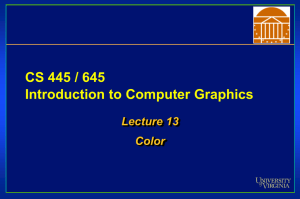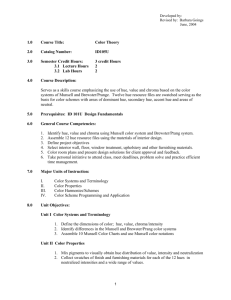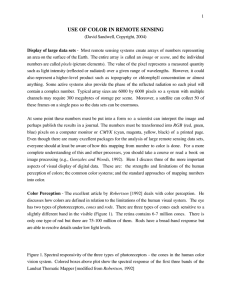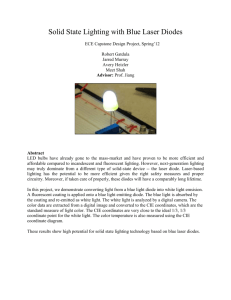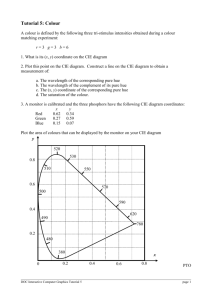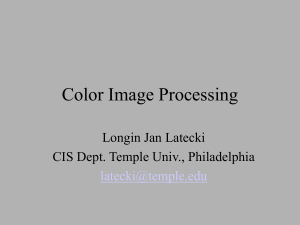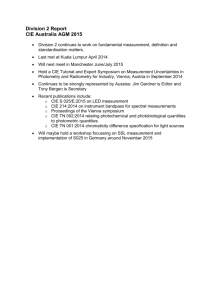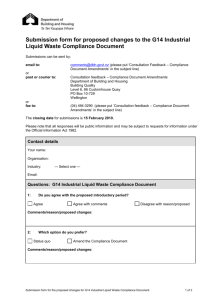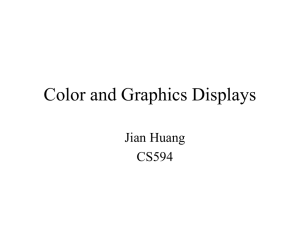Lecture 7: Color and its use
advertisement
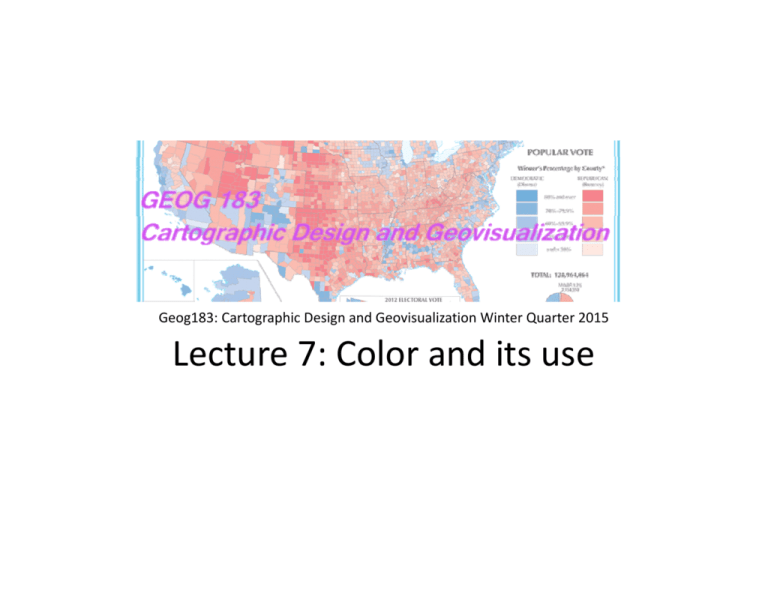
Geog183: Cartographic Design and Geovisualization Winter Quarter 2015 Lecture 7: Color and its use Color • • • • • Most powerful element in map symbolization Invokes unconscious, perceptual and cognitive responses Both input (eye) and output (video) concern in cartography Color rendering methods use additive and subtractive color Color models • Hardware • RGB • CMYK • User‐oriented • HSV • Munsell • HVC Not just a good idea, it’s the law • c = 299 792 458 m/ s • c= 670 444 951 miles per hour • Eye can process up to • Movies run at 24 FPS • TV runs at 30 FPS = 33 milliseconds/frame • Using 50 FPS, light can travel 5,995,849m between frames • Effect on light is motion blur at high velocities Wave theory of EMR: Polarization Dual Orthogonal Fluctuating fields EMR Theory Particle Theory of EMR Photons EMR has a wavelength • Wavelength () = c / v • Frequency (f) = 1/ • Amplitude (A) Intensity of EMR = Brightness • Energy content = E = f(# photons) • E = hc / Planck’s constant (h) • 6.626 x 10^‐34 Joules/second • Basic energy equation • E.g. UV and visible light on skin • UV shorter Electromagnetic spectrum “Pure” sunlight: absorption features ‘Solar Flux Atlas from 296 to 1300 nm’ by Robert L. Kurucz, Ingemar Furenlid, James Brault, and Larry Testerman: National Solar Observatory Atlas No. 1, June 1984. Light interactions • Shadowing (depth) • Reflection • Refraction • Scattering • Absorption • Re‐emission Spectrum and Absorption Light: Electrical and magnetic dimensions (Polarization) Rods and cones Theories of color perception • Trichromatic theory • RGB cones • Opponent‐process theory • Light dark and two color scales, red‐green and blue‐yellow • Both theories have value • Nerves fire at a constant rate • Above standard is excitation, below is inhibition Simultaneous contrast Almond illusion Rendering color • Depends on medium, but one major contrast • Subtractive color • Assumes background color is white, uses filtering pigments to add to surface to create color • Add little color, unsaturated and light • Add full color, saturated and darker • Non‐primary colors are blends of MCY • Additive color • • • • Assumes background is black Adds illumination to achieve color More color more saturated, more light brighter Non‐primary colors are blends of RGB Offset color lithographic printing Raster graphics Raster imaging technologies Display details • Aliasing and anti‐aliasing • Dithering • Frame buffers and the refresh rate • Movement periodicity http://en.wikipedia.org/wiki/Wagon‐wheel_effect Liquid Crystal Display Light Emitting Diodes • LED panels: conventional (using discrete LEDs) and surface‐mounted device (SMD) panels • A cluster of red, green, and blue diodes is driven together to form a full‐color pixel, usually square • pixels are spaced evenly apart and are measured from center to center for absolute pixel resolution • largest LED display in the world is over 500 meters long in Suzhou, China • largest LED television in the world is the Center Hung Video Display at Cowboys Stadium, which is 49 m × 22 m • LED TVs using SMD pixels of red, green, and blue diodes mounted in a single package, which is then mounted on the driver PC board • individual diodes are smaller than a pinhead and are set very close together • Reduces maximum viewing distance by 25% from the discrete diode screen at the same resolution Color models: Cube Color models: Wheel CMYK: Subtractive primaries Cyan, magenta, yellow, black HSV color model: Perceptual, but not all equal value Hue: Wavelength Saturation: Amount of pigment Value: Intensity or brightness Saturation Intensity Munsell color model Munsell layers CIE color model • Commission Internationale de l’Eclairage • Objective way to specify color • Based on three numbers Yxy • Two dimensional space for range of hue and saturation • Central white‐point (or equal energy) • Uses RGB theory, color combinations and human subjects for color repetition • Attempt to rectify perceptual difference in luminescence as a function of hue CIE color spaces CIE stimulus adjustment Diverging Qualitative Summary Color is complex and powerful Light behaves as both a wave and particles Light interacts with all aspects of map viewing Colors can be additive or subtractive Color models allow color specification and control Covered RGB, CMYK, HSV, Munsell and CIE Colorbrewer recommends color sequences for sequential, diverging and qualitative color sets • Don’t forget: Hue suggests class, saturation and intensity suggest value • • • • • • •

